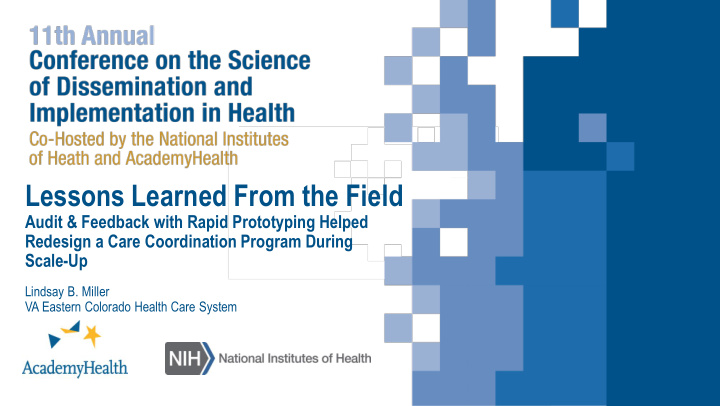



1 Lessons Learned From the Field Audit & Feedback with Rapid Prototyping Helped Redesign a Care Coordination Program During Scale-Up Lindsay B. Miller VA Eastern Colorado Health Care System
Disclosures 2 • No relevant disclosures • Disclaimer: The contents of this presentation do not represent the views of the Department of Veterans Affairs or the United States Government
Background 3 • Veterans with complex care needs often require services at both the Veterans Health Administration (VA) and non-VA community hospitals • Dual-use Veterans are at high-risk of adverse outcomes due to lack of cross-system coordination: • Be hospitalized and readmitted to the hospital within 30 days 1,2 • Have conflicting or duplicated tests and treatments 3,4 • Be less satisfied with their care 5
The Community Hospital Transitions Program 6 4 System Changes to Facilitate Coordination Community Hospital Transitions Nurse • Facilitates information transfer • Direct phone line for notification • Obtains follow-up appointments and • Electronic fax for discharge medications summary • Contacts Veterans after discharge • Care Card given to Veterans • Solves problems with end-users • Database built for evaluation
Community Hospital Transitions Nurse Workflow 5 Veteran Veteran is admitted to a receives follow community up with VA hospital Primary Care Transitions Nurse Transitions Nurse facilitates medical receives Transitions Nurse Transitions Nurse information notification about follows up with facilitates follow transfer: receives Veteran admitted Veteran post- up with VA discharge records at a Community discharge Primary Care and notifies VA Hospital Primary Care
Need for Recalibration 6 • Overwhelming Demand • 56 new Veterans each week on average • 37 community hospitals • Unintended Consequences High workload for 1 Transitions Nurse 1. Engaging 37 community hospitals in education is time consuming 2.
Implementation Strategies 7 • Audit and feedback • Weekly data reports and communication with study team • Rapid Prototyping • Revised initial intervention to reduce variability • 4 Core Components • LEAN approach
Community Hospital Transitions Program Core Components 8
Current Version of the CHTP 9 Process Changes Improvements • 4 Core Components • Greater buy-in • Recalibrated the scope of the CHTP • More timely notification of admission to fit workload • Accepted new patients through • 5 Top Community Hospitals hospital notifications or direct contact from patients • High-volume and greatest need • Real-time updates on VA system changes
Results 10 • 472 total Veterans who completed the intervention between 10/1/2017 and 9/30/2018 • Time between Veterans’ admission and our notification: 1.67 days • Time between the discharge date and date discharge summary received: 3.44 days • Time of first post-discharge call to Veteran by CHTN: 4.63 days • Time from discharge to VA follow-up appointment: 12.63 days
Lessons Learned 11 • Start slow--even if it feels too slow • Fewer completed interventions is better than many incomplete interventions • Record, analyze, implement, repeat! • Expanded to the VA Nebraska Western Iowa Health Care System in June 2018
Evaluation Framework 7 12 Reach How do I reach those who need this intervention? Maintenance Effecti ve ness How do I incorporate the How do I know my intervention so it intervention is is delivered over working? long-term? RE-AIM Adoption Implementation How do I develop How do I ensure organizational the intervention is support to delivered properly? deliver my intervention?
References 13 1. Axon RN, et al. Dual health care system use is associated with higher rates of hospitalization and hospital readmission among veterans with heart failure. Am Heart J . 2016;174:157-163. 2. Humensky J, et al. Service utilization of veterans dually eligible for VA and Medicare fee-for-service: 1999- 2004. Medicare Medicaid Res Rev . 2012;2(3). 3. Nguyen KA, et al. Medication Use among Veterans across Health Care Systems. Appl Clin Inform . 2017;8(1):235-249. 4. West AN, et al. Insured Veterans’ Use of VA and Non -VA Health Care in a Rural State. J Rural Health Off J Am Rural Health Assoc Natl Rural Health Care Assoc . 2016;32(4):387-396. 5. Nayar P, et al. Rural veterans’ perspectives of dual care. J Community Health . 2013;38(1):70-77. 6. Ayele RA, Lawrence E, McCreight M, et al. Study protocol: improving the transition of care from a non-network hospital back to the patient's medical home. BMC Health Serv Res. 2017;17(123). 7. Glasgow RE, Vogt TM, Boles SM. Evaluating the public health impact of health promotion interventions: the RE-AIM framework. Am J Public Health. 1999;89(9):1322-1327.
14 ACKNOWLEDGEMENTS PI: Catherine Battaglia Ashlea Mayberry Roman Ayele Marina McCreight Kelty Fehling Lindsay Miller David Gaskin Borsika Rabin Russell Glasgow Heidi Sjoberg Madhura Gokhale Mehret (Mercy) Tekle Tuula Kallioniemi CHTP site champion and Lynette Kelley Transitions Nurse Wenhui (Grace) Liu Funding Partners: QUERI
15 Questions?
16 THANK YOU! • Lindsay Miller, BA • Denver-Seattle Center of Innovation for Veteran Centered and Value-Driven Care • LindsayMiller8@va.gov @SeaDenCOIN
Recommend
More recommend